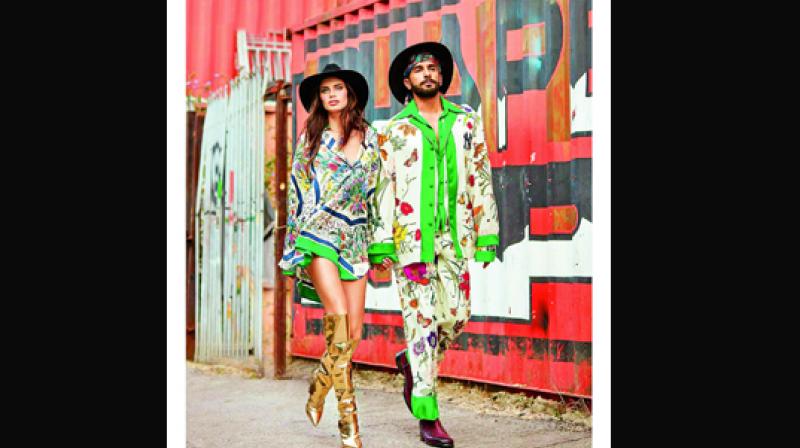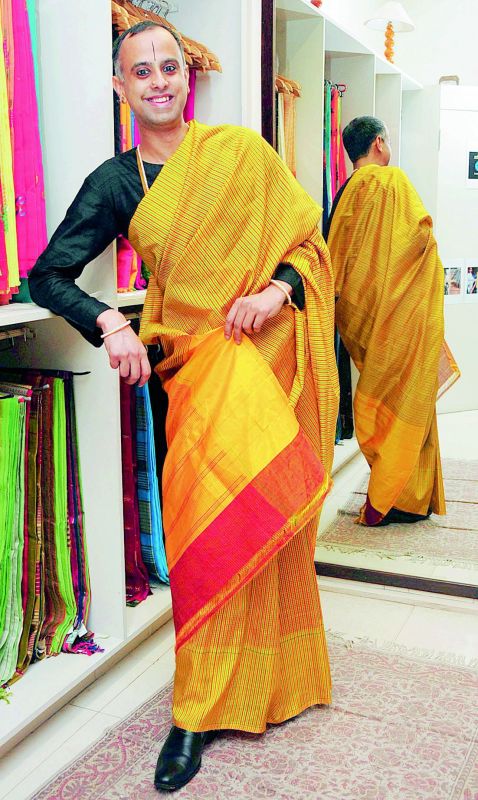Seeking Freedom in Fluidity

After the decriminalisation of Section 377 of IPC in India, a lot has changed for the LGBTQ community and most people in India now feel safe to express themselves and their sexuality in the open. However, even as the pre-historic laws are gone for good, is India ready to embrace the concept of gender fluidity without prejudice? Maybe, maybe not. And, not just in India but even in developed nations like the UK, it’s hard for laymen to understand that a few people, who do not want to exchange one role for another or confine themselves to one gender, are happy being both a man and a woman. In a recent case reported by The Daily Mail UK, gender fluidity led to a fight between a transgender and a man who chooses to cross-dress occasionally.
 Himanshu Verma of Red Earth often wears sarees.
Himanshu Verma of Red Earth often wears sarees.
Reportedly, a transgender star named India Willoughby lashed out at crossdressing male bank director, Philip Bunce, who occasionally dresses as a woman, for accepting a place on a list of the Top 100 Women in Business.
 Cara Delevinge was seen rocking a tuxedo and a top hat for Princess Eugiene’s royal wedding.
Cara Delevinge was seen rocking a tuxedo and a top hat for Princess Eugiene’s royal wedding.
Philip Bunce, who works at Credit Suisse, claims to be ‘gender fluid’ and ‘non-binary’ and splits his time 50-50 between Pippa and Philip — occasionally dressing in a wig and dress.
 Eshan Hilal, a professional belly dancer.
Eshan Hilal, a professional belly dancer.
We have to widen our minds and our horizons — and think of gender beyond dressing, feels Parmesh Shahani, Head Godrej India Culture Lab. For him, gender fluidity is about thinking of gender as something that is not binary — masculine or feminine, but rather something that flows. He says, “All of us are somewhere on the broad spectrum between a gender or genderless, having multiple genders, fluctuating between genders or cis-gender, which means identifying our gender behaviour with the sex we were born with — so masculine for male and feminine for female. As theorist Judith Butler famously stated in the 1990s, “Gender is performativity.” Thus, we all choose to perform our genders differently. For some it could include the clothes we wear, for others, it could be the pronoun we choose to identify with or the mannerisms we choose to adopt and for others, it could be neither — it could just be a feeling inside us. This is true both in India and other parts of the world.”
 Actor Will Smith’s son, Jaden Smith, has often been spotted in skirts, dresses and other androgynous clothing.
Actor Will Smith’s son, Jaden Smith, has often been spotted in skirts, dresses and other androgynous clothing.
Shahani further elaborates his reason by reminding us that gender fluidity has always been a part of the Indian culture. He adds, “When we hear stories from the Mahabharata for instance, of Arjun or Shikhandi — they are very gender fluid — as the celebrated mythologist Devdutt Pattanaik has often reminded us. So for us in India, it is not a new thing, but rather a reiteration of our rich plural cultural heritage, and the increased conversations around gender fluidity all around the world are a way of reminding us just how plural and inclusive we have always been.”

A good thing about gender awareness is that it leads to liberation — both mentally and physically — and, possibly that could be one of the reasons that heterosexual men are now breaking free from prevailing stereotypes. Thanks to the movies and pop culture, modern ‘metrosexual’ man has now decided to dismantle the traditional norms by embracing what’s perceived as feminine. Be it with fashion choices like skinny jeans, dhoti pants or with grooming habits like waxing, facials, etc. without any qualms. And, a significant number of men are now proudly participating in household activities and sharing parenting responsibilities, which were earlier considered a woman’s domain. Neglecting the set norms of masculine and feminine stereotypes has played a crucial role in the evolution of a society, and it is quite noteworthy when we see international icons like Cristiano Ronaldo (who is often seen as the epitome of masculinity) carrying a purse or shaping his brows or even crying in public.
 Actor Ranveer Singh was spotted wearing long skirts while promoting his movie Bajirao Mastani.
Actor Ranveer Singh was spotted wearing long skirts while promoting his movie Bajirao Mastani.
Perhaps, it’s quite an exciting time for heterosexual men who are willing to experiment with clothing, grooming and many other lifestyle aspects as well without being judged. Jason Arland, model and beauty influencer, says, “I am a boy who loves to play dress up and I don’t wish to be classified in any box. For me, wearing make-up or a dress is a way to express myself and I don’t wish to be judged for my choice of appearance. The way I choose to express myself has nothing to do with my colour or sexual orientation. When people ask about my gender expression or my identity, I prefer to answer them saying “I am a human being.” The beauty of gender fluidity and expression is that every human being is unique and special. It is about freedom of expression and we still have a long way to reach there.”
While most countries are still waking up to the idea of gender equality, some schools in Iceland are already doing their bit by raising kids without stereotypes. Reportedly, in Icelandic schools, young girls are encouraged to indulge in activities like climbing trees and walking on the snow, while boys are made to paint their nails and play with dolls. These role-reversed games open up the minds of children without creating a gender divide and expressing themselves more freely. Purushu Arie, a Chennai-based blogger who writes on gender-neutral fashion, feels the concept of gender fluidity and neutrality are the default settings of human psychology. According to Arie, no particular gender identity owns a style or clothing item. He says, “Products do not have a gender identity, our minds do. It is in our nature to process gender identities but how we assign those gender identities depends on the existing social norms. Gender norms have changed with time, cultures, geographical boundaries, and with people. Fluidity is the only thing constant about gender. The term cross-dressing exists because we’ve normalised particular attire/fashion for specific genders. We don’t point out cross-dressing with the same tone when a woman wears a blazer or a pair of trousers — because it’s normalised in this society. It wasn’t normal for women to wear a blazer or trousers a 100 years ago — it was outrageous back then.”
Speaking about his own experience with gender fluidity, Arie recalls his college years. He says, “My approach towards fashion became increasingly neutral when I started working on womenswear assignments at NIFT Delhi as a student. I wanted to design them in such a way that I could later wear them, instead of giving them away or locking them in a cardboard box. I later went on to shop outerwear and trousers from the womenswear section and surprisingly not many could notice the difference. As a society, I think we are doing more harm than good by associating clothing with sexuality. Tagging any particular attire or style with one’s sexuality only leads to stereotyping, and we must focus more on liberating ourselves from that. It’s probably due to the stereotypes that many heterosexual men, in particular, are often afraid to experiment with their clothing. Existing gender norms of masculinity are very sensitive to fashion. It takes something as simple as the colour pink to dismantle the entire notion of masculinity. In contrast, that kind of deep insecurity, on the basis of gender or sexual identity doesn’t concern women or trans people. A large number of women and trans, heterosexual or homosexual, comfortably switch from t-shirts-and-denims to a little black dress with no qualms.”
Some people find it outrageous today to see men wearing wigs and dresses — evidently men have worn wigs right from the ancient Egyptian era to Romantimes, even until the late 18th century in Europe. Men not only wore wigs but even dresses and make-up for the most part of clothing history. The fashion statements of the past are losing relevance in today’s time because we are becoming too prejudiced, feels Eshan Hilal, a professional belly dancer, and designer who embraces gender fluidity with pride. He raises a very important point when he states that “gender fluidity is regardless of sexuality.” He says, “Modern Indian society needs a revision of costumes and clothing from our history. Men and women wore similar clothing since the beginning of time. In the age of Mughals, both men and women wore angrakha, and a sari-like upper-body drape was seen on both genders during the Indus Valley Civilisation. There are abundant sculptures depicting men in elaborate drapes and even jewellery like nose rings, earrings, bracelets, waist ornaments and anklets. In the 70’s both men and women wore bell bottom pants, and heels that are worn by women today were actually made for men in ancient civilisations to depict class. History is full of such examples, and that’s what I tell them when someone questions me on my wearing a lehenga skirt with a t-shirt or bangles and bindi with denim or shorts. I choose to express my flamboyance and effeminate nature with my attire, and I don’t think anyone should have a problem with that.”
Somewhere because of gender tagging related to costumes and outer appearance, a divide was created between men and women several centuries ago. And when someone tries to break the set norm, we tend to automatically associate it with homosexuality. Reena Rai, founder of Miss Transqueen India, clarifies that gender fluidity and transgenders are very different concepts. She says, “To be a transgender, a person has to undergo several surgeries and hormonal treatments to totally convert to the opposite gender — it is a painful and long process, which requires a change of sex operation followed by prolonged counselling. It is not as same as gender fluidity, and that’s why we have barred many gender fluid people from entering this contest. We are now introducing the Transking India platform for women who have changed into men to promote awareness about this subject.”
For many people, gender fluidity is a way of life and medium to self-express with clothes and makeup, but it could also lead to certain awkward situations in day-to-day life. Delhi-based lawyer, Parth Mullick, thinks it is a matter of personal choice for someone to decide who he/she wants to wake up as in the morning irrespective of who one wakes up with. But it could be a matter of concern as it’s not just confined to the four walls of a bedroom but extends beyond it. He says, “The problem with having a gender fluid approach is not confined to a personal choice made in your bedroom and exercised there in your private space. What we need to see and understand is whether our society is comfortable with this way of life being exercised in the public space. It cannot be confined to wearing bangles or a nose pin one fine day, and neither should such a lifestyle be a problem in the fashion or film industry or some other non- conventional job.”
The gender fluid concept can backfire on certain occasions, especially when it comes to official and jurisdiction matters. Advocate Mullick argues, “What if a male dons feminine apparel and make-up in such a way that it is not possible to identify him by just looking at his picture on the Aadhar card or any other government document? Are the airports equipped to identify a person at the security check-in irrespective of a person’s dress? And whether such a person would like to be scanned in a private space where the women are checked by a woman constable or where men are scanned and checked? Is society willing to accept a judge or an advocate dressing up as a man one day and dressing up like a woman on another in the courtroom or a police officer at work doing the same? If a male is flying to another country, can he change and dress up like a woman if he desires on the flight and will he be accepted in the country of his arrival? While every way of life has its own pros and cons, the Government needs to do a lot of homework before giving such a concept a legal backing."
However, High Court lawyer Abishek Kaul points out that the concept of gender fluidity is much beyond the scope of our legal statutes, constitution and relates to India’s social structure. Gender fluidity is relatively new to Indian society, i.e. a society where even members of the bi-sexual community, gays, and lesbians strictly follow the dressing pattern of their own respective genders. “Those men who tend to cross-dress are considered feminine and are subjected to humiliation; on the other hand, women who choose to do it, come out as stronger personalities, thereby challenging patriarchal society. But things have changed in the recent past. For example, someone like Rituparno Ghosh, despite being a crossdresser for years, could well make movies, attend social events and still be accepted by society at large. On the other hand, for a commoner, it may turn out to be challenging," says Kaul.
Advocate Kaul emphasises that there is absolutely no legal bar on any individual to cross-dress, but there could be issues associated with it — one of which is acceptance by society. He remarks, “Gender fluidity may also at times create identification issues at public places and government offices. Here, the only precaution one needs to take is to ensure that there is an easy identification of face, especially in places having security concerns. Even though now, biometrics are being used by a majority of private enterprises and government undertakings for their employees but easy identification of employees would also be of utmost concern for such employers. I believe there seems to be a genuine apprehension amongst people vis-a-vis the burgeoning effect of gender fluidity, which in my opinion is fallacious. Even though it doesn’t seem like there is something in the offing, in terms of protection of gender fluidity by law, I am sure that the way our society has progressed in the last two decades, we will soon be able to adjust well with the concept of gender fluidity.”

